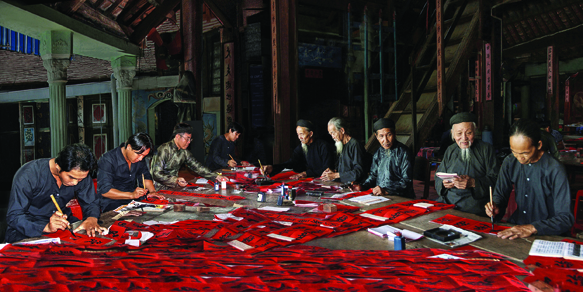BY DANG KHOA
(No.7, Vol.6, Sep-Oct 2016 Vietnam Heritage Magazine)
Writing calligraphy on Tet holiday at Long Son Big House, 2008
Photo : Pham Thi Ai Nghia
Evening on the 8 and 9 days of ninth lunar month every year is the time for the Double Nine Festival (this year the festival falls on 8 and 9 October), which takes place at the famous Long Son Big House, Long Son Commune of Vung Tau City to commemorate Sir Tran and to pray for health for all the people.
Sir Tran was the man who spent a lot of money and effort to build the Long Son Big House and who established a special life philosophy on Long Son Island.
Long Son Big House is a complex of many structures built in 1910. In 1991, it was recognized by the government as a national historical and cultural relic.
Days before the Double Nine Festival, the women of the village begin to prepare traditional foods and pastries typical of the Long Son Big House. Male villagers clean up the streets and decorate the Big House. The old men compose and write parallel sentences with beautiful meanings to hang at appropriate places.
On the 8th evening, they have an Ancestral Consecration with a non-vegetarian repast. The 9th is the main commemoration, and visitors are treated to free vegetarian meals. The simple ritual consists of burning incense to recall Sir Tran’s kind deeds and to pray for good health for everybody present. Many villagers are bare-footed, have bunned hair and wear clothes from Sir Tran’s time.
Though not as lavish as other festivities, thanks to the care, meticulous preparation and good name of Sir Tran and the Big House, the festival always attracts tens of thousands of people from far away.
According to the website of Culture, Sport and Tourism Department of Ba Ria-Vung Tau Province, Sir Tran’s real name was Le Van Muu. Born in 1855 at Ha Tien, Kien Giang Province, he fought the French colonialists. In 1900, when the fight was lost, to evade persecution, Mr Muu and 20 others of his family sailed waterways and came to resettle on Long Son Island. He always bunned his long hair, was barefooted and half naked and worked all day. That’s why people called him Sir Tran (‘tr?n’ means half naked).
On the new settlement, Sir Tran built shrines. He built houses for poor people coming to Long Son to start a new life. That made his house bigger and bigger. As the Long Son population grew, he built a school, bazaar, community house, rain and heat shelter and a preservation house.
All these structures were built with timber and old fashioned roof tiles on a 2ha area. When Sir Tran passed away, the Big House began to be called Sir Tran Temple by local people.

Cleaning up and decorating for the Double Nine Festival, 2008
Photo : Pham Thi Ai Nghia
Cultural architecture experts described, the temple as a complex of houses, following the style of community houses in Vietnamese villages. The houses of different sizes mingle without fences and without order. The whole lot looks strangely arbitrary, but very lively, thus impressing visitors deeply.
Perhaps because of Long Son Big House’s strange arrangement, on both my two visits I felt lost as if in a maze. Looking down from a hillside nearby, the disorder seems even more confusing. Inside every house, especially the ones that serve spiritual purposes, there are many antique wooden and bronze items, intricately carved.
Many experts say that Sir Tran collected from all parts of the country a lot of furniture such as tables, chairs, altar-cabinets, lacquered boards, altar pots . . . Among those, the most valuable are King Thanh Thai’s table set encrusted with granite and nacre, and 33 altar cabinets inlaid with nacre.
As he built shrines to worship Heaven, Buddha, Saints and Fairies, Mr Muu also practiced perfecting himself with five virtues: Humanity, Sensibility, Respect, Intellect and Faith. He advised people to wear simple Southern clothes, walk barefooted and bun their long hair behind the head with no hats. He also established new customs strange to Vietnamese traditions, such as burying the dead without coffins, and weddings with just a consecration ritual to ancestors, without lavish feasting.
After Sir Tran died on the 20th of the 2nd lunar month of 1935
——————-
Follow national highway 1A to the Northeast up to Vung Tau crossing, then turn right to national highway no. 51 and go 56km 900m to reach Long Son fork. Turn right and go 4km to another fork, then turn left and go further 1.5km to reach the Long Son Big House.

